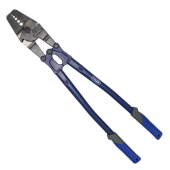We all use what we got but its accepted that when engaging in seat of the pants engineering with high current DC energy storage equipment, there is a high cost to be paid when we get it wrong. Especially when there are loved ones involved. I recommend scanning equipment with a thermal camera on a regular basis, while pushing up current delivery. Particularly mobile setups.
Cant disagree in the slightest. I don't recommend anyone follow in my footsteps, but generally i've been using my hand as the thermal sensing equipment on the 12-48v systems (after 'finding' and getting rid of pesky higher voltage AC on said circuits!!), with some consideration for avoiding the completion of a human circuit. I come from an automotive background, teach basic electrical courses, even have a certification for hybrid and electric vehicles, but i admit that messing with solar/battery setups has made me far more conscientious about the quality of CRIMPS. On a non-hybrid/ev car the only high-current circuits are the starter and alternator and the starter has such a short duration that its wiring is 'undersized' from the factory and only a truly terrible connection will cause a heat-related failure (melted lead battery terminal, for instance). On the alternator the duty cycle is much higher and heat-related damage is more likely, but still rare enough that almost no alternators are out there pushing current through hand-made terminations. Most are still going through factory-built original wiring. So I've had to improve my abilities to crimp a high-current connection, for sure. One of the things i've learned is the value of dielectric grease as a conductor.. of heat! Not so much for bolted ring terminals, but inside plastic connector bodies i've found that it helps the connection disperse heat much better so that it never reaches a damaging temp. An IDEAL connection wouldn't get hot in the first place, but I've got a LOT of used solar panels with MC4s that have sat open to the elements for long periods, and i've found dielectric to increase the reliability of those connections considerably. Short of replacing all old MC4s, i am still brainstorming an effective way to 'wire brush' those connections without disassembling every one..
That said, im still mostly doing it with a large hand-help cable ferrule crimper, not exactly a terminal crimper! Looks like this:

It doesn't go up to a large enough size to do anything bigger than about a 0 or 2/0 (i forget now) but while i have some 4/0 in my 48v system, it was all pre-terminated. I have not had to make a 4/0 termination so far and don't have equipment to do one nicely...yet.
Most of my heavy wiring is done using car battery cables. There are long runs of heavy cable when the battery is mounted in the trunk.
From what I have seen they are usually 2/0! One funny thing is opening the trunk of some of those cars and seeing a 2/0 positive wire and what looks like an 8ga or 6ga ground lead going to the body (chassis ground). Sort of relates to why i have rebar and gas pipe in my 12v system. I have heard that copper is something like 15x better as a conductor than iron. One way of interpreting that is just to use 15x more iron than you would have used copper! The case of the 'tiny ground wire' on those chassis grounded rear-battery vehicles is analogous, because 1ft of 6ga followed by 12ft of ENTIRE CAR is essentially as good or better a conductor than the 13ft of 2/0 because there is way more than 15x as much iron/steel as there is copper in the 2/0. There is so much metal that essentially the chassis acts like 'free wire length' and you are only comparing the resistance of 1ft of 6ga vs 13ft of 2/0.
I have a long (~40ft) pair of 'bus bars' made of rebar and black pipe to which i flux-core mig welded some small stainless bolts which have sets of leads going to 2 rows of parked vehicles' 12v batteries, about 5 vehicles per side and with a bunch of 'loose' 12v FLAs sitting on the ground hooked to it as well. This is essentially a large 'battery maintainer' system run by an 80a 12v aio inverter, but it also serves as 'backup power' if needed. It can flow about 50a without too much voltage drop, which when split (unevenly..) between a bunch of batteries is still a pretty small current and no objectionable heat is generated in any one location. It is ~40ft of rebar and gas pipe, hooked to 25' of 2ga CCA, to 4ft of 4ga, to 6" of 6ga into the AIO.





